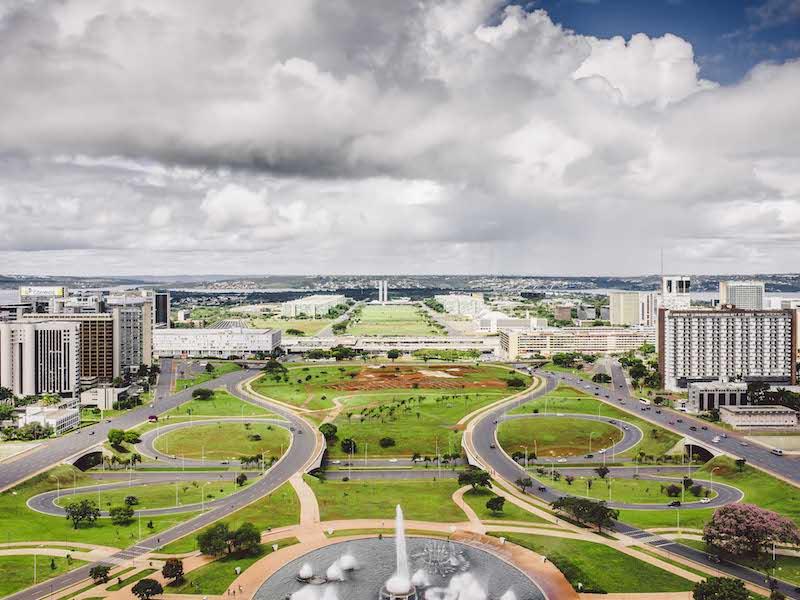Brasília – Brazil's Capital and Architectural City

Brasília is the capital of Brazil, officially founded on April 21, 1960. It is located in the Distrito Federal do Brasil, which has a little more than 3.05 million inhabitants in an area of 2,240 square miles.
The core city, the Plano Piloto administrative district, has 205,000 inhabitants and an area of 182 square miles. The Brasília metropolitan region, which extends into the states of Goiás and Minas Gerais, has about 4.29 million inhabitants and an area of 21,456 square miles.
Brasília was planned on the drawing board in 1956 by then-President Juscelino Kubitschek in collaboration with architects Oscar Niemeyer and Lúcio Costa and was built in just three years, after which it immediately became the capital of Brazil.
The center of Brasília has been a UNESCO World Heritage Site since 1987. So if you are interested in modern cultural history and find architecture exciting, you should definitely visit Brasília during your Brazil vacation!
Modern city buildings
Costa's idea for a capital city from scratch was as simple as it was ingenious. He drew a cross on a map and made it the basis of his plano piloto, his ground plan. To this day, the core city of Brasília is called this.
Along the longitudinal axis of the cross are state buildings and monuments, along the transverse axis residential areas and business districts. At the intersection of the cross is the heart of Brasilia's capital, the bus station. The central bus station is 2,297 feet long and strongly resembles a multi-level highway interchange with a supermarket parking lot on the top floor. But the view is simply impressive. Skyscrapers tower behind it, housing the country's most important companies.
From above Brasília looks like an airplane
The second axis of the cross, the transverse axis, is also the main artery. From the central bus station, it makes a slight arc to the south and to the north. From the air, therefore, it looks like the wings of an airplane and the longitudinal axis like its cockpit and fuselage. Brazilians have therefore always compared the shape of their capital to that of an airplane.
Over time, architect Lúcio Costa realized that the distance between the north and south wings would be too great, so he curved the wings. This combines architecture with art and makes the city even more impressive.
In the wings of the capital, Costa created an extensive system of roads. For he saw the car as the means of transport of the modern age. To this day, it is difficult for pedestrians to cross Brasília's multi-lane streets. East of the wings and the cockpit is also a 15.5-square-mile artificial lake.
Practical approach
Costa's goal was wide open spaces and clear forms. He was a follower of the French mastermind of modernism, Le Corbusier, for whom a city had to be functional above all. It was important to separate the living areas as much as possible in terms of urban planning and architecture. Separated from the work areas in Brasília, the wings of the plane therefore contain a large part of the residential neighborhoods, also called superblocks.
Their addresses consist of a logical but very complicated combination of numbers and digits that regularly drives strangers to despair. An example: SQS 708 H 44 is building 44 in block H (H 44) of the super square in the south zone (SQS) at the height 700 of the longitudinal axis and 8 of the south wing (708).
Political core
To the east, the view opens onto the end of the longitudinal axis, a six-lane road interrupted by a green belt that is rather brown in the dry season. At its edges stand 18 uniform disc houses, the federal ministries of Brazil. The axis ends at the "Square of the Three Powers", the masterpiece of the architect Niemeyer, who died in December 2012.
This refers to the presidential palace "Palácio do Planalto", the Supreme Court and the National Congress. Together they form the shape of an equilateral triangle. The shapes of the buildings were revolutionary new at that time. Niemeyer used the plastic deformability in Brasília like hardly anyone else before him.
Modern architecture
The landmark of the capital is the Congress Building, which houses the Senate and the Chamber of Deputies. The two plenary halls are located in the rectangular low-rise building and are clearly visible from the outside. The Senate chamber is located under a reinforced concrete dome, the Chamber of Deputies chamber under a shell. The two high-rise buildings house the offices of the deputies.
The cathedral of Brasília is also unique. It is round and consists of 16 curved reinforced concrete columns that open up to the sky. The large triangular glass panes between the columns let light into the large interior, which has room for 40,000 people.
In addition, there are many other architectural structures in Brasília, such as the Juscelino Kubitschek Bridge, the Itamaraty Palace, or the Torre Digital de Brasília, which are also extremely worth seeing and bear witness to an architectural masterpiece.
Modernity meets culture
Brasília is a promise fulfilled, representing modern Brazil. Here, a carefully planned city has been built and fused with Brazil's culture. As a result, architecture and art lovers can marvel at an impressive sight, as well as culture lovers can see a modern Brazilian history that is also the capital of the great country. So if your Brazil trip takes you inland, be sure to visit this city!
Sources: www.goruma.de, www.planet-schule.de, www.planet-wissen.de, www.wikipedia.org

